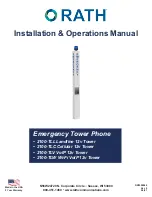
Copyright 2010-2015 Obihai Technology, Inc.
47
•
The latest Call in other states
A user can also force a call to be the call-in-focus from the GUI. The operation triggered by pressing the Call Key applies
to the call-in-focus only according to its current state.
Line Monitor Keys
Not to be confused with a line key, a line monitor key monitors the status a line, whether it is up or down, has calls
ringing, holding or connected. Pressing the key may result in:
•
Answer an incoming call if there is one. If there are more than one, answer the oldest one
•
Start dial tone, if there are spare capacity
Speed Dial Keys
The Speed Dial function lets the user configure a speed dial number from the phone GUI. User can press and hold down
the speed dial key until the feature key item shows up on the screen. From there the user can configure the speed dial
details. The service to use for calling with the speed dial may also be configured. This function supports the Push to Talk
PTT option.
Note: There are in addition to the spee dial feature keys 99 configurable speed dial numbers that may be invoked by
dialing the corresponding 1-2-digit speed dial code (that is, 1 – 99) like a regular number. These 99 speed dial storages
are referred to as the “
Speed Dials 99
” feature that is entirely independ of the speed dial feature keys discussed here.
BLF Keys
BLF or Busy Lamp Field is described in detail in a later section. A BLF key is used to monitor the call status of another
extension. This feature operates in the context of an SP service. In many cases the BLF key also acts as a speed dial key
to call or transfer a call to the monitored extension. This key also supports PTT when it is used to call the monitored
extension. Note that the call or call transfer to the monitored extension will use the same underlying SP service.
Presence Monitor
This function is used together with a Buddy List. You can configure a feature key to monitor the presence/status of a
buddy in a buddy list. You can also use this key as a speed dial to that buddy. Note that the Buddy List feature operates
in the context of an SP service. The call to the buddy by pressing a presence monitor key will use the same underlying
SP service to make the call. The PTT option is NOT available with this key when calling the buddy.
Group Page Keys
OBi1000 supports two (multicast) page groups called Page Group 1 and Page Group 2 respectively. A feature key must
be set up with the function Page Group 1 or Page Group 2 in order to use the respective page group. Paging is one-way;
incoming audio will not be played by the phone when the user is talking. The configuration of each page group has a
Push-To-Talk option which can be enabled such that user must press the page key to talk. The key also lets the user the
join or leave the group with one key press. For example when the user does not want to be bothered by incoming page,
he can temporarily leave the group. The LED color also reflects the current group-joining status as a reminder to the
user.
















































